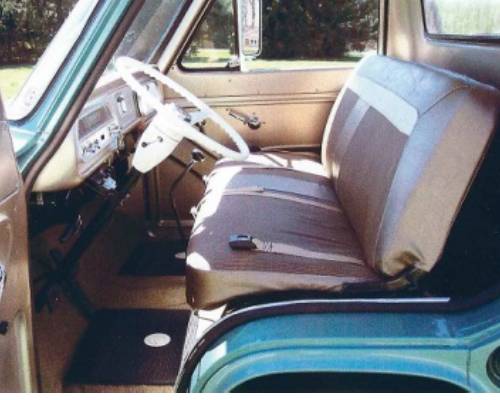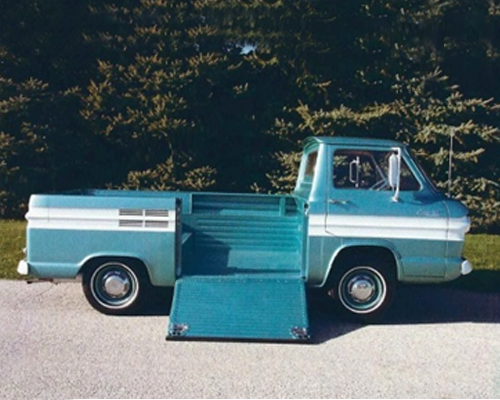This truck does not fit in the category of “Stand & Drive” delivery trucks that I collect and restore. It is a delivery truck but the main reason I bought it was the uniqueness and that it is a rare truck. There were less than 18,000 units produce in its four years of production. The other interesting thing is that it was the only American pickup produced that had a rear mounted air cooled engine. This unit has the flat 6 cylinder 80 HP engine and a four speed manual transmission. The other unique feature of the truck is that you sit over the front axle and your feet ride in front of the front axle. It is like drive a flat face bus or motor home.
This truck was owned and restored by a local friend who was a Covair enthusiast. He owned this Rampside, a Corvair Panel Truck, a Corvair Sedan and a Corvair Convertible.
(The following is copied from the October 2007 issue of Hemmings Motor News by David LaChance)
If Chevrolet’s Corvair proved not to be the stake through the heart of Volkswagen that the GM brass hoped it would be, you couldn’t blame the division for lack of effort. Chevrolet spun out the lineup in every direction it could think of, offering not only coupes, sedans, convertibles and station wagons, but also a line of forward-control light trucks that included two pickups, the Loadside and the Rampside, to take on their counterparts from Wolfsburg.
The Corvair 95 trucks–the name was derived from their 95-inch wheelbase, in contrast to the passenger cars’ 108-inch wheelbase–joined the lineup for the 1961 model year. Like the passenger cars, they featured rear-mounted, air-cooled, 80hp flat-six engines driving the rear wheels through a three-speed synchromesh transaxle.
They offered more power than Volkswagen’s pickups, and could be had with Chevrolet’s two-speed Powerglide, or a four-speed manual. The gross vehicle weight rating of 4,700 pounds meant that they could handle a payload of up to three-quarters of a ton.
Chevrolet beefed up the flat-six a bit for cargo-toting duty, giving it more durable exhaust valves, exhaust valve rotators, lowered compression and carburetors with larger jets for a richer mixture. When the passenger-car engine was enlarged from 145-cu.in. to 164-cu.in. in 1964, the forward-control engine followed suit, gaining a heavy-duty, 12-plate oil cooler. The default final-drive ratio for the pickups was 3.55:1, though 3.27:1 could be specified for highway cruising, or 3.89:1 for heavy hauling or steep hills. Powerglide-equipped pickups were fitted with a transmission cooler, mounted under the battery box. Chevrolet initially fitted the Corvair 95 with a front suspension based on that used on full-size Chevrolets, later switching to the full-size pickups’ setup. The rear was a heavy-duty version of the swing-axle rear suspension.
Both trucks featured a two-door cab with an integrated double-walled cargo box that measured 105 inches by 45 inches. Construction was semi-unitized, with a subframe providing support for the cargo area. The Loadside was a conventional pickup with a tailgate. Because the back end of the load floor was raised to make room for the engine, access to the cargo area was poor. The Rampside, in contrast, featured a brilliant idea: Part of the passenger side of the truck was hinged at the bottom, and could be lowered to form a ramp to the cargo bay. A bit of rubber trim on the edge kept the paintwork from being scratched when the ramp was lowered. In both trucks, access to the engine was gained by unscrewing a steel panel that formed part of the floor.
The new trucks sold well at the start, with production totaling 13,262, more than 80 percent of which were the novel Rampside. In 1962, sales slumped to 4,471, with Loadsides tumbling to an insignificant 369. Only the Rampside remained after 1962; its production numbers continued their death spiral, falling to 2,046 for 1963, 851 for 1964, and zero for 1965.




